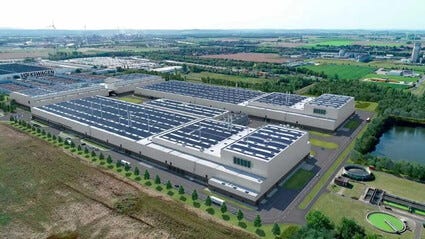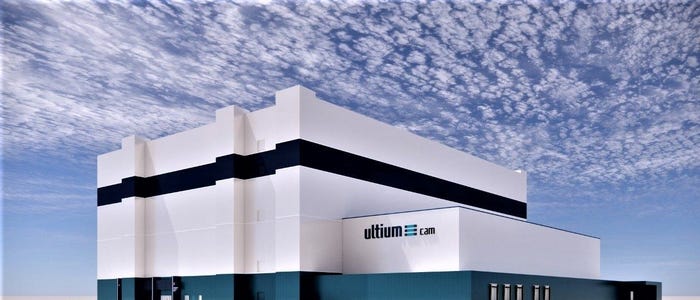Canadian Auto Industry, Politicians Defend EV SubsidiesCanadian Auto Industry, Politicians Defend EV Subsidies
Brian Kingston of the Canadian Vehicle Manufacturers’ Assn. says Canada had little choice but to assist Volkswagen, given the shift to base the supply chain for North America’s EV assemblers in the region and away from Asia ̶ specifically China.

OTTAWA ̶ The Canadian auto sector and governments appear united in saying the huge subsidies sunk into securing a C$7 billion ($5.1 billion) Volkswagen battery plant in southern Ontario make good commercial and economic sense.
The level of financing could indicate what the Canadian and Ontario governments will have to spend to persuade Stellantis to restart stalled work at its planned battery manufacturing plant in Windsor, across the border from Detroit.
Construction has been halted while talks continue over the level of subsidies, which the two governments had agreed upon in March, before the U.S. Inflation Reduction Act’s Advanced Manufacturing Production Credit was approved and before the initial Stellantis announcement. The subsidies initially involved federal and provincial payments totaling C$1 billion ($735 million).
For VW, however, talks took place after the IRA was approved last August and have seen the federal government pledge spending between C$8 billion ($6.3 billion) and C$13.2 billion ($9.7 billion) until 2032 in exchange for the German automaker siting its plant in Ontario (see rendering, below).

VW St. Thomas ON gigafactory (VW)_0
Those payments will come after the plant is completed and starts making and selling batteries in 2027, being tied to sales, with a Canadian-equivalent subsidy of $35 per kWh being paid until it is reduced by 25% in 2030, with the same reduction following in 2031 and 2032 and no subsidy in 2033.
The subsidy deliberately matches the IRA Advanced Manufacturing Production Credit and would be reduced further if the U.S. cuts its own auto-battery subsidies.
The Stellantis subsidies originally were not linked to future production like the VW subsidies were, but Stellantis now wants a similar deal.
Brian Kingston, Canadian Vehicle Manufacturers’ Assn. CEO and president, says the Canadian federal government had little choice but to provide the subsidies, given the shift to base the supply chain for North America’s EV assemblers in North America and away from Asia ̶ and China specifically: “If you don't compete with the Americans, every single (EV and EV-related) facility will go to the United States,” he says. “We have a unique, once-in-a-lifetime chance to increase our share of the industry.”
David Adams, president and CEO, Global Automakers of Canada, says the Biden Admin. is “perhaps more protectionist than (its) predecessor,” so money needs to be spent, combined with diplomacy to “ensure that the Americans increasingly see Canada as part of them against the world,” rather than outside the tent.
Speaking at a launch event at St. Thomas, ON, site of the VW battery plant, Prime Minister Justin Trudeau declared, “We are delivering a national anchor for Canada’s electric-vehicle supply chain.”
His government’s strategy has been backed by the Ontario government, even though unlike previous EV subsidy deals, the province has not matched the federal spending. That said, it has pledged C$500 million ($368 million) in direct incentives to VW and is “investing hundreds of millions of dollars more,” including local infrastructure improvements to roads, railways, water, electricity, and police and fire safety.
Vic Fedeli, Ontario’s minister of economic development, job creation and trade, tells Wards public money invested in Ontario’s auto sector makes good sense: "When we took office (in 2018), GM closed in Oshawa (in 2019) and there were 100,000 people whose (auto sector) jobs were in jeopardy,” he argues. But now, “We’re in the EV business today and among the largest suppliers” worldwide, he says, stressing the survival of the Ontario auto sector during the shift to EVs is now assured.
Meanwhile, the Ontario government is working to develop a comprehensive supply chain, Fedeli says. That includes potential new lithium and nickel mines near Timmins in northern Ontario, as well as new nickel and rare-mineral production further north in the region south of James Bay.
Fedeli says his government is also looking for intermediate battery supply chain investment in plants for lithium hydroxide processing and making cathodes, anodes, separators, copper foil and aluminum foil – with each plant potentially involving C$1 billion-C$3 billion ($735 million-$2.2 billion).
Kingston agrees a comprehensive supply chain, from critical minerals to EV assembly, offers opportunity for Canada. He anticipates further announcements of processing and component plants supplying battery makers, with South Korea’s SK IE Technology assessing Ontario sites to make battery separators, for example.
An example (also with a hefty subsidy attached) is a planned cathode-active-materials plant at Bécancour, QC, run by GM and South Korea’s Posco Future M, which should start operations in 2025. Under construction between Montréal and Québec City, the plant will benefit from C$150 million ($110 million) from both the Canadian and Québec provincial government, which will meet about one-third of the C$600 million ($441 million) investment costs.
The Bécancour project (see rendering, below) will supply GM plants in the U.S. and the GM BrightDrop production line in Ingersoll, ON.

GM-Posco Quebec battery plant
The size of the VW subsidy and other public investments may also attract more investment, Adams says: “The VW investment sends a clear signal to the world that Canada is a key player.”
Without support from the federal and provincial government, the risk of losing Canadian auto capacity during the EV transition is real, says Ross McKenzie, board director at ITS Canada (Intelligent Transport Systems) and former managing director of WatCAR, the University of Waterloo Centre for Automotive Research, in Ontario: “(Politicians) have recognized a well-established, stable economic contributor to society is going through a metamorphosis. If you are not going to evolve…you are going to have shuttered plants.”
Canada has a competitive advantage as a safe and ethical supplier of EV critical minerals, McKenzie adds.
That these subsidies have not drawn criticism from the federal Conservative opposition is telling, McKenzie says. It reflects consensus over the value of auto jobs (including 500,000 indirectly employed serving auto workers and plants), and that EV investments are green – less controversial than, say, an oil/gas pipeline.
But the Canadian Taxpayers Federation is unhappy about the VW subsidy: “Taxpayers don’t have $13 billion to give to a multinational corporation,” says Franco Terrazzano, its federal director. If the federal and provincial governments spend the same amount keeping Stellantis’ battery plant in Windsor, he will doubtless have grounds for more criticism.
About the Author
You May Also Like

